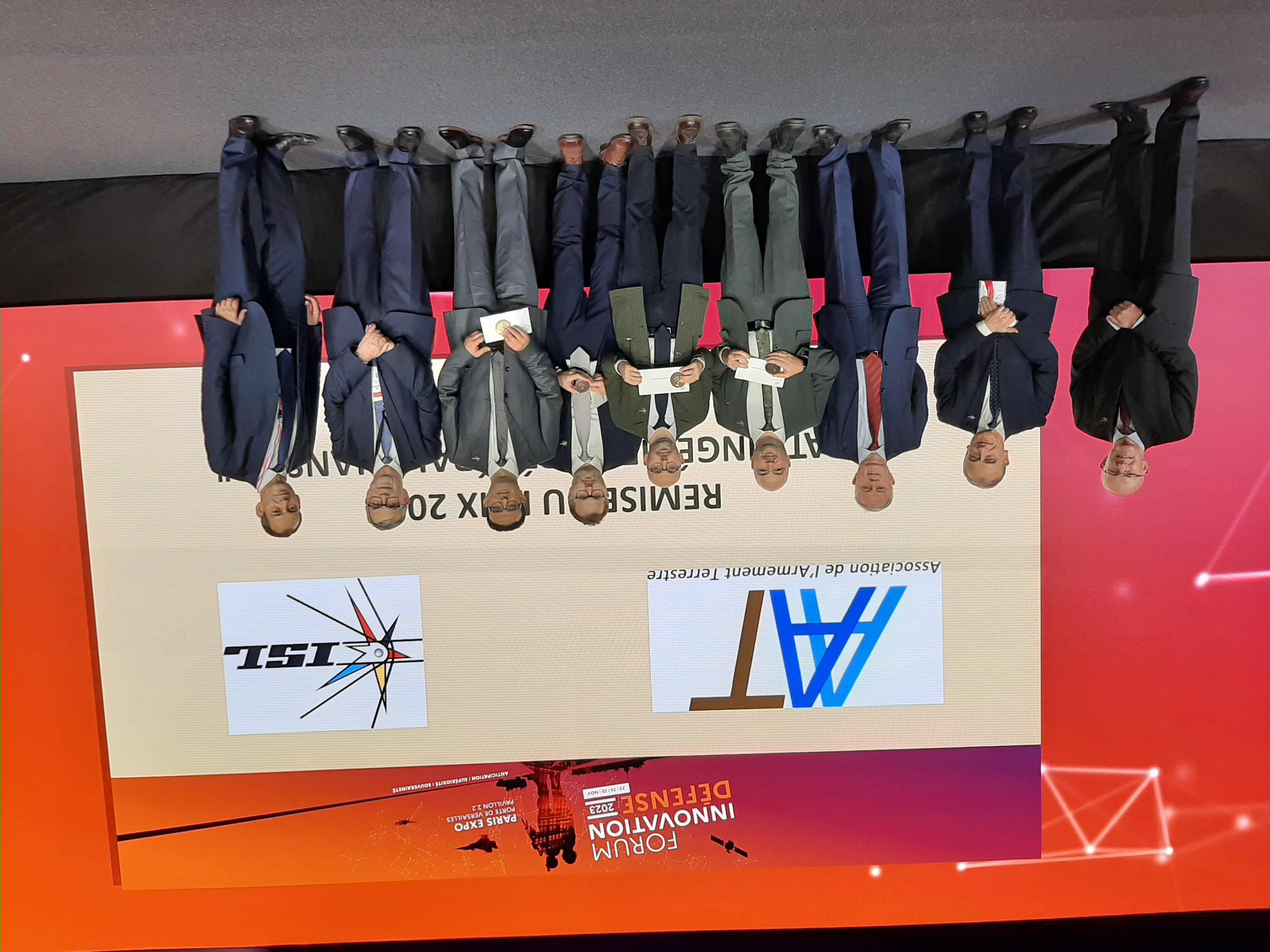[24/11/2023]
The 50th AAT - Ingénieur général Chanson Award goes to Sébastien Changey, Emmanuel Pecheur, Ronan Adam and Nabil Jardak for their disruptive scientific work on magnetometer-based navigation of guided projectiles
Marc Damon, chairman of GICAT, the French land defence and security industry association, handed over the 50th AAT Ingénieur général Chanson Award to Sébastien Changey, Emmanuel Pecheur, Ronan Adam and Nabil Jardak, a team of three researchers and an engineer from the French-German Research Institute of Saint-Louis (ISL) during an official ceremony at the Innovation Defence Forum 2023 in Paris. This award recognises the excellence achieved in the disruptive scientific and technical work they have performed on magnetic-inertial navigation systems for guided ammunition based on flight dynamics models.
Created in 1972, this award has been won five times by ISL staff members.
Many important personalities representing the military, academic and industrial world attended the official award ceremony.
Precise ammunition is an important operational need
In addition to range, one of the main priorities for current and future artillery systems is improving the precision of ammunition. Greater on-target precision increases the efficiency of ammunition use, reduces ammunition consumption to achieve the same effects and mitigates the risk of collateral damage.
In order to optimise precision, guided ammunition is necessary and the navigation system is one of the indispensable technological bricks involved. Such a navigation system must be able to deliver the position, speed and angular position of the projectile in real time. Generally speaking, the navigation system relies on fusion algorithms of data from a GNSS (Global Navigation Satellite System) receiver and from an inertial navigation system (IMU, inertial measurement unit). All these electronic components must be able to withstand an artillery gun launch.
Currently, low-cost high-g hardened IMUs are not available on the European market.
Sovereignty, precision and lower costs thanks to the ISL innovative navigation system based on magnetometers
This innovative ISL-designed system dispenses with the constraints linked to gyroscopes which are highly acceleration-sensitive and submitted to bans on import. This system is also more precise, due to the ammunition’s flight dynamic model, while using low-cost sensors. In addition, it offers more functions than a traditional inertial navigation system since it provides not only angular speed and acceleration data but also the projectile’s angular position, speed and position with such a precision that it enables on-target terminal guidance with a GNSS-free seeker. Since the GNSS-system can be easily jammed, it is has indeed become important to design projectile guidance systems which do not rely on GNSS.
Thanks to the experimental shots carried out at ISL, the viability of this technology has been demonstrated for projectile navigation, both for direct flat shots and for ballistic trajectories. All the work on the electronic components and their integration into the demonstration projectiles have been conducted at ISL. This new navigation system can be implemented in guided ammunition, terminal-guidance fuses for conventional artillery ammunition as well as loitering ammunition.
ISL’s disruptive research work on magnetic-inertial navigation based on a flight dynamic model for guided ammunition has reached a high technology readiness level, enabling it to be transferred to the defence industry in the near future.
Thanks to the support of both the French and German Ministries of Defence, Sébastien Changey has been working on this subject since 2002. The innovation process occurred step by step, together with his team and thanks to the multidisciplinary work at ISL.
Outlook: research work still on-going
Given the current strategic context with the war in Ukraine, there is no doubt that artillery will remain a major operational force on a battlefield where GNSS-jamming is common. GNSS-free navigation continues to be a core research subject for ISL. Work on innovative, low-cost technologies insensitive to GNSS-jamming are on-going.
Such innovative navigation systems developed by ISL and designed for use in artillery projectiles, UAVs and loitering ammunition meet more than ever before the future needs of the armed forces and contribute to strengthening the strategic autonomy of the European Union.
AAT and the AAT-Ingénieur Général Chanson Award
The aim of the French Association of land armament (AAT) is to bring together the main stakeholders of French land armament: DGA (French procurement and technology agency), armed forces, industry as well as research centres, in order to develop a common strategy on air-land weapon systems.
A graduate of the French École Polytechnique, IGA Paul Chanson, PhD, officer of the French army corps of Engineers, was one of the founders of the French nuclear weapons programme. The Chanson-Award was instituted in 1972 to perpetuate the memory of Professor Chanson and honours innovative projects in the area of ground military defence and practical applications.

Photo of the 50th AAT - Ingénieur Général Chanson-Award being handed over to the ISL winning Team on the 24th November 2023 during the 2023 FID.





